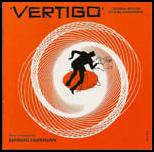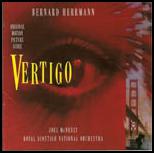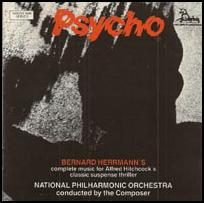SHARPENING KNIVES -
BERNARD HERRMANN'S
SCORES
FOR 'VERTIGO' & 'PSYCHO'
Review by Howard
Davis
The New Zealand Symphony Orchestra reached out beyond their classical repertoire on Saturday night. Their adventurousness was richly-rewarded, as the deeply appreciative Wellington audience was given the opportunity not only to see a couple of Alfred Hitchcock's greatest films, but also to hear fine renditions of two of Bernard Herrmann's most accomplished film scores.
Herrmann was born in New York in 1911 and made his name as a composer for CBS radio. His first effort at film scoring was 'Citizen Kane' and, like Orson Welles, he was viewed with suspicion by the film community. His Hollywood career was fraught with difficulties, many of his own making. He was passionate, irascible, and unpredictable, often treating film executives with contempt. As the head of MGM's music department recalled "I think Benny Herrmann committed suicide. Unwittingly; not with drugs, not with a pistol, but with a four-letter word called hate. I'm convinced that he filled his life with unneeded stress and tension."
Herrman's overarching ambition was to make his name as a composer of concert music and a conductor on the international circuit, but if he considered himself a failure in this regard, then he sadly undervalued his achievement. Over four decades, he revolutionized movie scoring by abandoning the decorative approach that had previously dominated film scoring and imposing his own distinct harmonic and rhythmic syntax. Instead of lush melodies, he wrote short, obsessively repeated figures, static collections of chords, and parodies of past styles. His sound was always original, sometimes experimental, and complemented perfectly the visceral cutting style of many of the directors with whom he collaborated. He died in 1975, on the night of the last recording session of Martin Scorsese's 'Taxi Driver.'
Hitchcock had grown frustrated with the merely illustrative type of score perfected by Central European emigres like Max Steiner and Erich Korngold. While filming 'Lifeboat,' he worried that audiences would wonder where the music was coming from, out in the middle of the ocean. ''Ask Hitchcock where the cameras come from'' was composer David Raksin's famous response. Hitchcock was not deaf to music, but wanted to change the way it was used and enjoyed experimenting with 'live', or diegetic, sources: in 'Rope,' Farley Granger's guilt-ridden character nervously plays Poulenc at the piano; with 'Rear Window,' strains of cocktail piano stream in from an adjacent apartment. Hitchcock tried to hire Herrmann several times before finally signing him for 'The Trouble With Harry,' the first of nine films they worked on together. He discovered a composer whose music not only blends into the action, but also addresses regions of the subconscious, summoning a miasmic sense of the macabre and paralyzing dread. His music plays its own starring role, sometimes even taking over the action.

'Vertigo' (1958) was Herrmann's fourth score for the director, who in many ways was his temperamental opposite. In 'Vertigo: The Making of a Hitchcock Classic,' Dan Auiler wrote "When he felt a musician or a fellow composer wasn't meeting his own standards of perfection, Herrmann was capable of flying into fits of rage … But somehow, the artistic sensibilities of these two artists bridge emotional differences. Perhaps it was Herrmann's respect for Hitchcock's abilities as a film director. Perhaps it was Hitchcock's working style, which allowed fellow artists to work at their own pace and on their own, leaving Herrmann to contribute without confrontation."
Herrmann was a master of film scoring, and 'Vertigo' is a symphony for both film and orchestra. In a perspicacious article for the 'New Yorker,' Alex Ross described how its byzantine plot perfectly matched his Gothic sensibilities and closely resembled Korngold's operatic masterpiece, 'Die Tote Stadt,' in which a man similarly tries to make over a woman in the image of his dead lover. During Saul Bass' title sequence (a hypnotic design of spirals rotating in space, overlaid with uncanny shots of Kim Novak's eyes), the music rotates in tandem - endless circles of major and minor thirds, interspersed with shuddering dissonances. Herrmann did not invent this off-centre tonality (it was also employed by Rimsky-Korsakov, Debussy, and Ravel), but the sense of relentlessness is entirely his own. The music perfectly complements the dominant mauve and green colour scheme, finding no acceptable tonal resolution as it spirals back on itself, and inducing a literal feeling of nausea.
The creepy, somnambulistic sequence in which Scottie stalks Madeleine is shrouded in a ghostly, foggy light: we see him driving through San Francisco; Madeleine buying flowers; more driving; Madeleine walking through a chapel and a cemetery; driving again; and Madeleine sitting at the Palace of the Legion of Honor art gallery. There are a couple of brief bits of dialogue as Scottie gathers information about the places he visits, but 'Vertigo' essentially becomes a silent film for fifteen minutes - except for the music, which plays almost continuously and provides the sequence with its air of ineffable mystery. It is the music as much as the lighting and gauzy filters that gives those scenes their eerie shimmer, shifting fluidly, but uneasily, among a few simple, cryptic augmentations of familiar triads. Wistful hints of melody circle back on themselves instead of building into thematic phrases. The orchestration is dominated by high or low instruments, notably violins and bass clarinets. The sequence is profoundly disturbing, but also very beautiful, neither precisely tonal, nor entirely dissonant.
This music of expectation, which somehow communicates a visitation from the past, returns with ever-darkening effect several times later in the film. Herrmann moves into even more obscure territory in the scene where Scottie and Madeleine visit a grove of giant sequoias. Here he plays with cluster chords - piled-up collections of tones that would be shockingly dissonant if they were not so lustrously soft and low. It is a measure of Herrmann's daring that more than a few measures in this sequence could have been composed by the American experimentalist Morton Feldman.
When Scottie declares his love for Madeleine (all of HIichcock's heroines have names that begin with M - for Mother or Murder?), Herrmann faced a very different challenge - to write love music circumscribed by destructive obsession. In the cue called 'Scène d'Amour,' he refers to Wagner's 'Tristan und Isolde,' citing the sweeping phrases of the 'Liebestod,' the savage leitmotif of daylight, the black-as-night Prelude to Act III, and the delirious ecstasy of the central love scene. Even at its most ecstatically upward-rushing, it is disturbed by passing dissonances and undercut by harmonic rootlessness, thus avoiding any trace of sentimentality. It is the soundtrack of Scottie's compulsively obsessed mind, making the final tableau at the San Juan Bautista Mission all the more disturbing in its abrupt finality. Herrmann, steeped in Victorian melodrama, wrote a fanfare for the triumph of Fate with all dialogue finally out of the way.
Film composers are often accused of being derivative and sometimes their borrowings are shameless (e.g. Danny Elfman's wholesale plundering of Nina Rota). Herrmann's use of Wagner, however, is both deliberate and subtle. The main melodic contour and the harmonies are his own idiosyncratic construction. He is jogging the memory of those who know 'Tristan' and the subconscious of those who do not. His veiled citations indicate the unstoppable recurrence of the past. The score is not simply an illustration of the film, but a metaphor for it.
When 'Vertigo' was first released, audiences were confused by its long, rambling plot and critics generally reacted unfavorably, yet it is Herrmann's oneiric scoring that makes the film so unforgettable. It not only vastly enriches the images, but has also found a life outside the film. There are two CD versions available - the original soundtrack, conducted by Muir Mathieson, and an excellent re-recording by the Royal Scottish National Orchestra, conducted by Joel McNeely. Sadly, the original 1958 recording suffered from less than ideal conditions and Herrmann was upset that he was not allowed to conduct it because of a musicians' strike. Most of it was recorded in London, the rest in Vienna, and the playing sometimes sounds ragged and murky. Auiler suggests "Herrmann was never happy with the Mathieson recordings. At the time, [Herbert] Coleman wrote to the director of the Vienna orchestra that Hitchcock and Herrmann were happy with the results, although the letter hints that there may have been complaints - among them a certain dissatisfaction 'about the heavy bowing sound from the strings.' But the letter goes on to assert that that was exactly the effect Herrmann had been after ... Later, though, Herrmann would contend that the recordings were sloppy and full of mistakes. Newly restored and re-released in 1996, the recording does reveal some sloppiness on the part of the musicians."
Herrmann's work remains a puzzling paradox. Most of his ''serious'' compositions don't quite come off, yet his film scores can be performed effectively in concert, as Esa-Pekka Salonen, the rigorously European-trained conductor of the LA Philharmonic, proved with his Herrmann anthology on the Sony Classical label. In his biography, Herrman himself commented, "This whole rubbish of other people orchestrating your music is so wrong ... To orchestrate is like a thumb-print. I can't understand having someone else do it. It would be like someone putting color to your paintings."

Two years later, Herrmann composed one of his most innovative and frequently imitated scores for Hitchcock's seminal horror film 'Psycho' (1960). The use of strings for what Fred Steiner called his "black and white music" was unheard of at the time, but Herrmann's score was much more than just those "shrieking strings" in the murder scenes. It sets the entire mood of the movie and gradually raises the level of suspense to its terrifying climax. It fully deserved to win an Oscar, but incredibly was not even nominated.
Hitchcock insisted that Herrmann write the score for 'Psycho' even though he refused to accept a reduced fee for the film's low budget. Hitchcock was so pleased with the tension the score added to the film that he later acknowledged "33% of the effect of 'Psycho' was due to the music." Herrmann's singular contribution can be inferred from the penultimate placement of his name in the opening credit sequence, followed only by Hitchcock's directing credit. Herrmann's biographer Steven C. Smith writes that the music for the shower scene is "probably the most famous (and most imitated) cue in film music," but Hitchcock originally opposed having music in the scene at all. When Herrmann played the shower scene cue for Hitchcock, he reminded the director of his instructions not to score this scene, to which Hitchcock replied, "Improper suggestion, my boy, improper suggestion."
Herrmann used the small music budget to his advantage by writing for a string orchestra rather than a full symphonic ensemble, contrary to Hitchcock's request for a jazz score. He thought of the single tone colour of the all-string soundtrack as a way of reflecting the monochromatic cinematography. The strings play con sordini (with a muting device placed across the bridge) for all the music other than the shower scene, creating a darker and more intense effect. Hollywood composer Fred Steiner pointed out that the use of strings provided Herrmann with a wider palette in terms of tone, dynamics, and instrumental special effects than any other single instrumental group would have.
The main title music - a tense, hurtling cue - sets the tone of impending violence, and returns three times on the soundtrack. Herrmann maintains tension through the slower moments in the film through the use of ostinato, and although nothing shocking occurs during the first twenty minutes, the title music remains in our mind, supplying a subliminal sense of tension to the early scenes. In the prelude, Janet Leigh wears a white bra and slip, but when she decides to steal Hitchcock dressed her in black underwear, visually signifying her transition from the good girl in love to the bad temptress who must be punished for her transgression. When she checks into the Bates motel, the music cuts out completely as Marion flushes her ripped up sums down the toilet (shown for the first time in a Hollywood film) and steps into the shower. Suddenly, a shadowy figure appears behind her, the shower curtain is torn back, and we hear the sound of high-pitched, bird-like, slashing strings. This cue was known as 'The Knife' in Herrmann's score, accompanying her blood-curdling screams (Hitchcock insisted on using ice-cold water) and amplifying the sadistic horror of the scene like sheets of lightning.
There were rumors that Herrmann used electronics, including amplified bird screeches, to achieve this intensely savage effect, but it was in fact created using only violins, with a screeching, stabbing sound-motion of extraordinary viciousness. The only electronic amplification employed was the placing of the microphones close to the instruments, to achieve a harsher sound. Besides the direct emotional impact, the shower scene cue also ties the soundtrack to birds, effectively foreshadowing that it is Norman, the stuffed-bird collector, who is the murderer rather than his mother. George Martin has admitted borrowing the same slashing string figures for his arrangement of the Beatles' 'Eleanor Rigby, but creates a quite different sense of plangent wistfulness.
The following sequence in which Norman meticulously mops up and disposes of the evidence is another extended passage without any dialogue, just the pulsating, circular melody. Roger Ebert points out how Perkins does an uncanny job of establishing his complex character: "He has a young man's likability, jamming his hands into his jeans pockets, skipping onto the porch, grinning. Only when the conversation grows personal does he stammer and evade. At first he evokes our sympathy as well as Marion's … we identify with Norman - not because we could stab someone, but because, if we did, we would be consumed by fear and guilt, as he is. The sequence ends with the masterful shot of Bates pushing Marion's car … into a swamp. The car sinks, then pauses. Norman watches intently. The car finally disappears under the surface. Analyzing our feelings, we realize we wanted that car to sink, as much as Norman did."
Musicologists have discussed the use of the E flat 'psycho chord' that accompanies the fragmentation of Saul Bass’ disjointed title sequence in terms of a fractured structure that augments the unsettling quality of the prelude. The transformations of the 'psycho chord' and the word 'psycho' have been interpreted as both a visual and musical manifestation of Norman’s psychosis, foreshadowing his eventual breakdown. The subsequent manipulation of these notes suggest the dissolution in Norman's state of mind from harmonic resolution to the dissonance of the 'psycho chord,' which becomes the main tonic harmony of the piece. Norman’s unstable psyche never fully resolves itself, but constantly veers back to the dissonant sonority of the psychotic mother. Its interruptions at the beginning, the end, and throughout the prelude form a kind of Doric column that supports the film's narrative structure.
Herrmann’s score creates a similar effect to the off-screen voices we hear in the movie, suggesting that the key to understanding its function is not so much how it is used, but rather when. It is these non-diegetic voices - both out of body in the soundtrack and the musical voices of the score - that ultimately make 'Pyscho' so terrifying. The underscore signals a sudden subjective shift as Anthony Perkins slides deeper into insanity and accompanies a second voice speaking from within. The rapid shift through these disparate musical and vocal motifs indicates a powerful sense of rhythmic interaction, just as the first few minutes of music establish the out-of-control downward spiral of Marion’s personal morality. It is the identical E-flat 'psycho chord' that returns to assault Marion during the shower scene. Hitchcock’s stated view of the composer's role supports this idea - “When musicians compose a score, or orchestrate, they make sounds rather than music.” Herrmann simply sharpens Norman’s knife.



 Prostate Cancer Foundation: Foundation Hails Select Committee Support For Prostate Screening Pilots
Prostate Cancer Foundation: Foundation Hails Select Committee Support For Prostate Screening Pilots Cross Street Music Festival: First Artists Announced For 2025 Cross Street Music Festival
Cross Street Music Festival: First Artists Announced For 2025 Cross Street Music Festival Bowls New Zealand: Lawson And Grantham Qualify To Keep Bowls Three-Peat Hopes Alive
Bowls New Zealand: Lawson And Grantham Qualify To Keep Bowls Three-Peat Hopes Alive Te Whatu Ora Health NZ: Health Warning – Unsafe Recreational Water Quality At South Bay And Peketā Beaches And Kahutara River Upstream Of SH1
Te Whatu Ora Health NZ: Health Warning – Unsafe Recreational Water Quality At South Bay And Peketā Beaches And Kahutara River Upstream Of SH1 Wikimedia Aotearoa NZ: Wikipedian At Large Sets Sights On Banks Peninsula
Wikimedia Aotearoa NZ: Wikipedian At Large Sets Sights On Banks Peninsula Water Safety New Zealand: Don’t Drink And Dive
Water Safety New Zealand: Don’t Drink And Dive